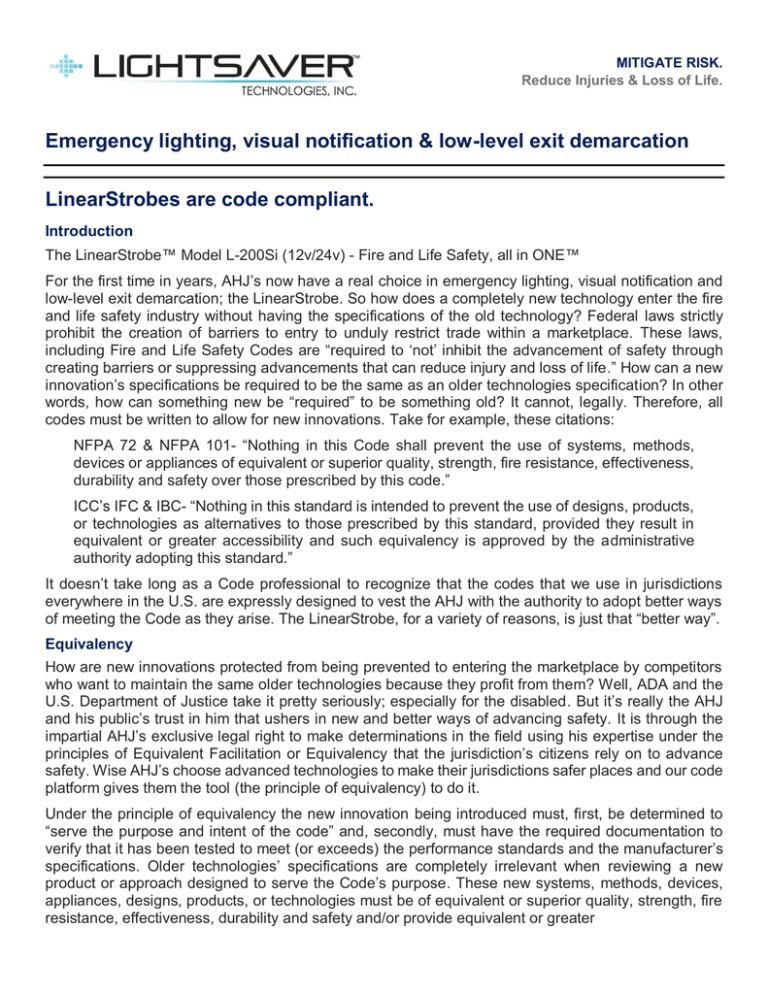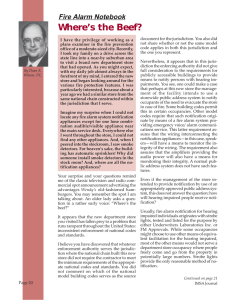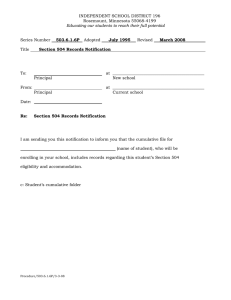
MITIGATE RISK.
Reduce Injuries & Loss of Life.
Emergency lighting, visual notification & low-level exit demarcation
LinearStrobes are code compliant.
Introduction
The LinearStrobe™ Model L-200Si (12v/24v) - Fire and Life Safety, all in ONE™
For the first time in years, AHJ’s now have a real choice in emergency lighting, visual notification and
low-level exit demarcation; the LinearStrobe. So how does a completely new technology enter the fire
and life safety industry without having the specifications of the old technology? Federal laws strictly
prohibit the creation of barriers to entry to unduly restrict trade within a marketplace. These laws,
including Fire and Life Safety Codes are “required to ‘not’ inhibit the advancement of safety through
creating barriers or suppressing advancements that can reduce injury and loss of life.” How can a new
innovation’s specifications be required to be the same as an older technologies specification? In other
words, how can something new be “required” to be something old? It cannot, legally. Therefore, all
codes must be written to allow for new innovations. Take for example, these citations:
NFPA 72 & NFPA 101- “Nothing in this Code shall prevent the use of systems, methods,
devices or appliances of equivalent or superior quality, strength, fire resistance, effectiveness,
durability and safety over those prescribed by this code.”
ICC’s IFC & IBC- “Nothing in this standard is intended to prevent the use of designs, products,
or technologies as alternatives to those prescribed by this standard, provided they result in
equivalent or greater accessibility and such equivalency is approved by the administrative
authority adopting this standard.”
It doesn’t take long as a Code professional to recognize that the codes that we use in jurisdictions
everywhere in the U.S. are expressly designed to vest the AHJ with the authority to adopt better ways
of meeting the Code as they arise. The LinearStrobe, for a variety of reasons, is just that “better way”.
Equivalency
How are new innovations protected from being prevented to entering the marketplace by competitors
who want to maintain the same older technologies because they profit from them? Well, ADA and the
U.S. Department of Justice take it pretty seriously; especially for the disabled. But it’s really the AHJ
and his public’s trust in him that ushers in new and better ways of advancing safety. It is through the
impartial AHJ’s exclusive legal right to make determinations in the field using his expertise under the
principles of Equivalent Facilitation or Equivalency that the jurisdiction’s citizens rely on to advance
safety. Wise AHJ’s choose advanced technologies to make their jurisdictions safer places and our code
platform gives them the tool (the principle of equivalency) to do it.
Under the principle of equivalency the new innovation being introduced must, first, be determined to
“serve the purpose and intent of the code” and, secondly, must have the required documentation to
verify that it has been tested to meet (or exceeds) the performance standards and the manufacturer’s
specifications. Older technologies’ specifications are completely irrelevant when reviewing a new
product or approach designed to serve the Code’s purpose. These new systems, methods, devices,
appliances, designs, products, or technologies must be of equivalent or superior quality, strength, fire
resistance, effectiveness, durability and safety and/or provide equivalent or greater
MITIGATE RISK.
Reduce Injuries & Loss of Life
Emergency lighting, visual notification & low-level exit demarcation
accessibility over those prescribed by the code used in the jurisdiction in order to be approved by the
governing AHJ.
By virtue of being tested and listed to the very highest standards of performance in the industry, UL
1971, the LinearStrobe is already pre-qualified and readied for AHJ approval using equivalency for its
use in any application where lower performance standards, such as UL 924 and UL 1994, etc. apply.
Test reports, listing confirmations and other supporting studies and data are readily available for free
for AHJ’s considering the LinearStrobe for a variety of uses in emergency lighting, visual notification
and low-level exit demarcation applications.
Purposes
The obvious purpose of the LinearStrobe™ is “to alert people to an emergency condition (like fire)
“and” to help them to locate the exits and/or path of egress below stratified smoke layers.” It
simultaneously Alerts, Demarks “and” Directs; effectively meeting or exceeding the intended
purpose of the Codes that require devices or appliances in the visible notification, exit & egress
signage/path marking and emergency lighting classifications. The LinearStrobe clearly serves the
intended purposes of the Codes that regulate these 3 primary and very different fire and life safety
fronts:
VISUAL NOTIFICATION: The purpose of visible notification appliances is to flash in
synchronized fashion to “alert” the deaf and hearing impaired to the existence of a
fire emergency condition.
EXIT & EGRESS SIGNAGE/MARKING: The purpose of low-level exits signs is to
help people locate the path of egress below the stratified smoke layers.
EMERGENCY LIGHTING: The purpose of emergency lighting systems is to
“minimize danger to life from the effects of fire, including smoke, heat, and toxic gases
created during a fire” and “to allow for the prompt escape of occupants from buildings
or, where desirable, into safe areas within buildings”.
In all 3 of these very different emergency signaling platforms, the minimum requirements are
established. The LinearStrobe™ clearly “Serves the Purpose” intended by the Codes and has the
definite capability to take the place of older, and many times less effective technologies, which are
traditionally utilized to satisfy these code requirements today.
As an example: Compare the LinearStrobe around an exit doorway (connected to a NAC driven by a
FACP) with conventional visible notification appliances. The purpose of visual notification appliances
as outlined above, Alert, synchronize and visually indicate that a fire emergency condition exists in the
space to the hearing impaired. Both, the LinearStrobe and older strobe appliances can do this and both
are marked to UL standards (UL 1971) to certify their capabilities. But, unlike the older technologies
(like xenon-based wall or ceiling strobes) which are required by Code to be installed up high on the wall
where they can quickly become obscured by thick black smoke, LinearStrobes provide their
synchronized alerting in a multi-elevational way providing highly visible light at both, high “and” low
levels. In addition to higher-elevational alerting, the LinearStrobe also delivers its unique format of
appropriately intense highly visible light at “floor level” to serve the Code’s purpose. This new system,
MITIGATE RISK.
Reduce Injuries & Loss of Life
Emergency lighting, visual notification & low-level exit demarcation
method, device, appliance, design, product, or technology (The LinearStrobe) is both equivalent ‘and’
superior in quality, effectiveness, durability in smoke and is safer as a result. It also clearly provides
greater accessibility to both the deaf ‘and’ other occupants that exceed those prescribed by the code.
This configuration provides a much longer period of visibility for the hard of hearing occupant to directly
identify, get to and move through the exit to safety under the stratified layers of smoke as the smoke
builds and chokes out lights from conventional appliances.
Primary & Supervised
All UL 1971 Listed devices are primary devices because only UL 1971 devices are permitted to connect
to the notification appliance circuit (i.e., the NAC). No Secondary/Auxiliary Devices are allowed to
connect to the NAC, and secondary devices do not flash in sync with other primary visual notification
appliances integrated in the same circuit. LinearStrobes are supervised just like all older UL 1971 visual
notification appliances and can be field calibrated to marry their flash to sync with all other visual
notification appliances in the line of sight and connected zone. In an effort to clarify, examples of
Secondary/Auxiliary visual notification devices are devices such as flashing doorbells and flashing
telephones, which do not serve the primary purpose of visual notification in Fire and Life Safety Codes.
NFPA 101- Life Safety Code© Compliant
The purpose of the life safety code is to “minimize danger to life from the effects of fire, including smoke,
heat, and toxic gases created during a fire” and “to allow for the prompt escape of occupants from
buildings or, where desirable, into safe areas within buildings”. In this arena, LinearStrobes are, once
again, superior to older technologies designed ages ago to serve this Code’s intended purpose. Not
only does it identify the path of egress in the event of smoke or fire like their dated counterparts, they
also simultaneously provide flashing “alerting” low-level exit demarcation that is not easily obstructed
like point-source flush-mount/low-level exit signs, and, even more importantly, LinearStrobes are visible
from any angle of approach, unlike in-wall or flush-mount exit demarcation technology.
Additionally, where photoluminescent tapes and exit signage are utilized, LinearStrobes are an infinitely
more reliable form of low-level exit demarcation technology; especially where occupancy sensors or
chronic low-light conditions in spaces may hinder the charging effectiveness of the photoluminescent
materials used.
ADA CompliantLinearStrobes not only level the playing field for individuals who are deaf or hearing impaired, but they
can also enhance building accessibility for many high-risk groups including people with a variety of
physical or cognitive disabilities and medical conditions by increasing the amount of time the occupant
has during critical moments in a fire to identify the path of egress below thick black smoke and direct
them to safety. LinearStrobes, are listed to the UL 1971- Standard for Signaling Devices for the Hearing
Impaired and, obviously address the particular needs of the deaf. However, this technology also has
tremendous importance for a variety of disabilities such as people with intellectual and other
developmental disabilities, the partially sighted, those with low-vision (including some legally blind
individuals), those with known mobility difficulties, and/or those whom would likely suffer difficulties in
safe evacuation as a result of long-term physician prescribed medication which might reasonably impair
his/her ability to safely mobilize or evacuate in a fire or emergency event.
MITIGATE RISK.
Reduce Injuries & Loss of Life
Emergency lighting, visual notification & low-level exit demarcation
The technology is designed specifically with the Americans with Disabilities Act of 1990 and a myriad
of other accessibility codes and laws in mind. The device's wide availability and designed ease-ofinstallation permits the quick deployment of the technology and it is a reasonably affordable and readily
achievable solution to increase accessibility.
The LinearStrobe is taking a path similar to older strobes as it enters into service under
ADA/Accessibility law. ADA’s platform through the use of the principle of equivalency for the benefit of
the disabled brought the strobe industry to life and created quite a stir when ADA was enacted. ADA,
the supreme law of the land in the accessibility realm, technically, required that all strobes have light
intensities of at least 75 candela. Consider that, had our industry not cleverly re-invented its approach
to light intensity, room sizes and coverages on-the-fly, we might all be installing minimum 75cd strobes
everywhere. But for the principle of “equivalency”, not one 15cd, or 30cd strobe light would ever been
compliantly installed to meet code requirements. But, obviously, millions of these devices were
“approved” throughout our nation, simply because AHJ’s understood the equivalency principle and
“approved” them. This understanding of equivalency and AHJ’s drive to flexibly embrace new ways of
making the public safe is fundamental to the LinearStrobe’s future.
People Focused Design™
LinearStrobes are meticulously designed based on People-Focused Design™ principles. An example
of this approach in design is how it was applied to the appliance’s light output intensity level. The light
intensity of even a 15 candela strobe that is designed to create high-intensity indirect point-source
ambient light from high on a wall or ceiling (in thick black smoke) with hopes to provide enough light for
an occupant to be able to identify the exit at a distance, could easily create flash blindness to occupants
at floor level (below the thick black smoke) with a direct view where they are crawling within inches of
the light source. The LinearStrobe, on the other hand, is specifically designed to operate at a light
intensity that is appropriate for its logical proximity to human eyes. It is thoughtfully designed, with the
impact to those that it serves as a primary consideration. In this case, in an effort to create the least
likely possibility of creating flash blindness to occupants as they crawl at floor level and within inches
of the luminary when approaching it and passing it as they pass through the exit portal, a People
Focused Design™ approach was required. Obviously, the high intensity of older strobes is the driving
reason why Code actually requires them (conventional strobes) to be installed at 80” or above finished
floor elevations. If the LinearStrobe had an intensity of, even 15 candela, it would, like an older strobe
technology, have high probability of creating flash blindness to occupants when their eyes are within
inches of the luminary. Similarly, low-level exit signs do not flash, therefore the intensity of the luminary
required a People Focused Design approach as well. The LinearStrobe is designed to serve the
intended purpose of the Code, but in a more effective way.
Summary
LinearStrobes are a first and only “break-though” innovation that are Compliant with both, Fire and Life
Safety Codes. This extremely versatile Fire and Life Safety technology serves many purposes in the
Codes and is an obvious best choice for the informed AHJ for specific applications and locations. Its
pedigree of listings, certifications and unmatched versatility sets it apart from any other device or
appliance in the marketplace today. LinearStrobes provide AHJ’s with a new choice in code compliant
egress path marking, visual notification and low level exit demarcation. We believe they will chose
wisely.
~~~
LightSaver Technologies, Inc. and its affiliates. San Clemente, California
The information provided in this document is intended for use as a guideline and is not intended as, nor does it constitute, legal or professional advice.
LightSaver does not warrant that adherence to, or compliance with, any recommendations, best practices, checklists, or guidelines will result in a particular
outcome. In no event will LightSaver or any of its subsidiaries or affiliates be liable in tort or in contract to anyone who has access to or uses this information.
LightSaver does not warrant that the information in this document constitutes a complete and finite list of each and every item or procedure related to the
topics or issues referenced herein. Furthermore, federal, state or local laws, regulations, st andards or codes may change from time to time and the reader
should always refer to the most current requirements. This material does not amend, or otherwise affect, any prior contract, arrangement or agreement
between LightSaver and any other party.
©2015 LightSaver Technologies, Inc. All rights reserved. LightSaver’s logos are trademarks of LightSaver Technologies, Inc., San Clemente, CA and
other countries.




